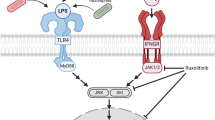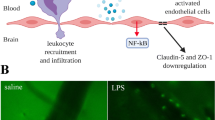Abstract
Accumulating evidence suggests that histone deacetylase inhibitor exert neuroprotective effects in animal models of neurological diseases. We investigated for the first time whether class I histone deacetylase inhibitor valproic acid (VPA) can reverse cognitive deficits in a mouse model of sepsis-associated encephalopathy (SAE). Moreover, the possible mechanisms of protection were also explored. A mouse model of SAE was induced in adult male mice by cecal ligation and puncture (CLP). Mice received an administration of saline or VPA (100 mg/kg) once daily for 14 consecutive days starting either immediately or 2 weeks after operation. Furthermore, the TrkB antagonist K252a was used in another group of experiment to investigate whether brain-derived neurotrophic factor (BDNF)-TrkB signaling pathway is involved in the protection of VPA. Our data suggested that CLP resulted in significant cognitive impairments accompanied by increased expressions in interleukin-1β and caspase-3, and decreased expressions in BDNF, phospho-TrkB (pTrkB), postsynaptic density 95, and synapses, which were reversed by VPA. However, TrkB antagonist K252a abolished the beneficial effects of VPA with regard to cognition and decreased pTrkB expression and synapses in the hippocampus. Taken together, the findings of the present study suggested chronic treatment with VPA reverses cognitive deficits through mechanisms probably via a reduction in inflammation and apoptosis in the brain, as well as the activation of the BDNF-TrkB signaling pathway in a mouse model of SAE.











Similar content being viewed by others
References
Iwashyna TJ, Ely EW, Smith DM et al (2010) Long-term cognitive impairment and functional disability among survivors of severe sepsis. JAMA 304(16):1787–1794. doi:10.1001/jama.2010.1553
Iwashyna TJ, Cooke CR, Wunsch H et al (2012) Population burden of long-term survivorship after severe sepsis in older Americans. J Am Geriatr Soc 60(6):1070–1077. doi:10.1111/j.1532-5415.2012.03989.x
Gofton TE, Young GB (2012) Sepsis-associated encephalopathy. Nat Rev Neurol 8(10):557–566. doi:10.1038/nrneurol.2012.183
Granger JI, Ratti PL, Datta SC et al (2013) Sepsis-induced morbidity in mice: effects on body temperature, body weight, cage activity, social behavior and cytokines in brain. Psychoneuroendocrinology 38(7):1047–1057. doi:10.1016/j.psyneuen.2012.10.010
Peleg S, Sananbenesi F, Zovoilis A et al (2010) Altered histone acetylation is associated with age-dependent memory impairment in mice. Science 328(5979):753–756. doi:10.1126/science.1186088
Guan JS, Haggarty SJ, Giacometti E et al (2009) HDAC2 negatively regulates memory formation and synaptic plasticity. Nature 459(7243):55–60. doi:10.1038/nature07925
Gräff J, Rei D, Guan JS et al (2012) An epigenetic blockade of cognitive functions in the neurodegenerating brain. Nature 483(7388):222–226. doi:10.1038/nature10849
Gräff J, Tsai LH (2013) Histone acetylation: molecular mnemonics on the chromatin. Nat Rev Neurosci 14(2):97–111. doi:10.1038/nrn3427
Ji MH, Zhu XL, Liu FF et al (2012) Alpha 2A-adrenoreceptor blockade improves sepsis-induced acute lung injury accompanied with depressed high mobility group box-1 levels in rats. Cytokine 60(3):639–645. doi:10.1016/j.cyto.2012.08.002
Kilgore M, Miller CA, Fass DM et al (2010) Inhibitors of class 1 histone deacetylases reverse contextual memory deficits in a mouse model of Alzheimer’s disease. Neuropsychopharmacology 35(4):870–880. doi:10.1038/npp.2009.197
Koike H, Fukumoto K, Iijima M et al (2013) Role of BDNF/TrkB signaling in antidepressant-like effects of a group II metabotropic glutamate receptor antagonist in animal models of depression. Behav Brain Res 238:48–52. doi:10.1016/j.bbr.2012.10.023
Wan Y, Xu J, Ma D et al (2007) Postoperative impairment of cognitive function in rats: a possible role for cytokine-mediated inflammation in the hippocampus. Anesthesiology 106(3):436–443
Head BP, Patel HH, Niesman IR et al (2009) Inhibition of p75 neurotrophin receptor attenuates isoflurane-mediated neuronal apoptosis in the neonatal central nervous system. Anesthesiology 110(4):813–825. doi:10.1097/ALN.0b013e31819b602b
Mombelli M, Lugrin J, Rubino I et al (2011) Histone deacetylase inhibitors impair antibacterial defenses of macrophages. J Infect Dis 204(9):1367–1374. doi:10.1093/infdis/jir553
Shakespear MR, Halili MA, Irvine KM et al (2011) Histone deacetylases as regulators of inflammation and immunity. Trends Immunol 32(7):335–343. doi:10.1016/j.it.2011.04.001
Roger T, Lugrin J, Le Roy D et al (2011) Histone deacetylase inhibitors impair innate immune responses to Toll-like receptor agonists and to infection. Blood 117(4):1205–1217. doi:10.1182/blood-2010-05-284711
Dash PK, Orsi SA, Zhang M et al (2010) Valproate administered after traumatic brain injury provides neuroprotection and improves cognitive function in rats. PLoS One (6):e11383. doi:10.1371/journal.pone.0011383
Kazantsev AG, Thompson LM (2008) Therapeutic application of histone deacetylase inhibitors for central nervous system disorders. Nat Rev Drug Discov 7(10):854–868. doi:10.1038/nrd2681
Li Y, Liu B, Gu X et al (2012) Creating a “pro-survival” phenotype through epigenetic modulation. Surgery 152(3):455–464. doi:10.1016/j.surg.2012.06.036
Sailhamer EA, Li Y, Smith EJ et al (2008) Acetylation: a novel method for modulation of the immune response following trauma/hemorrhage and inflammatory second hit in animals and humans. Surgery 144(2):204–216. doi:10.1016/j.surg.2008.03.034
Peng GS, Li G, Tzeng NS et al (2005) Valproate pretreatment protects dopaminergic neurons from LPS-induced neurotoxicity in rat primary midbrain cultures: role of microglia. Brain Res Mol Brain Res 134(1):162–169
Imamura Y, Wang H, Matsumoto N et al (2011) Interleukin-1β causes long-term potentiation deficiency in a mouse model of septic encephalopathy. Neuroscience 187:63–69. doi:10.1016/j.neuroscience.2011.04.063
Comim CM, Barichello T, Grandgirard D et al (2013) Caspase-3 mediates in part hippocampal apoptosis in sepsis. Mol Neurobiol 47(1):394–398. doi:10.1007/s12035-012-8354-x
Yokoo H, Chiba S, Tomita K et al (2012) Neurodegenerative evidence in mice brains with cecal ligation and puncture-induced sepsis: preventive effect of the free radical scavenger edaravone. PLoS One 7(12):e51539. doi:10.1371/journal.pone.0051539
Suda S, Katsura K, Kanamaru T et al (2013) Valproic acid attenuates ischemia-reperfusion injury in the rat brain through inhibition of oxidative stress and inflammation. Eur J Pharmacol 707(1–3):26–31. doi:10.1016/j.ejphar.2013.03.020
Devi L, Ohno M (2012) 7,8-dihydroxyflavone, a small-molecule TrkB agonist, reverses memory deficits and BACE1 elevation in a mouse model of Alzheimer’s disease. Neuropsychopharmacology 37(2):434–444. doi:10.1038/npp.2011.191
Diógenes MJ, Costenla AR, Lopes LV et al (2011) Enhancement of LTP in aged rats is dependent on endogenous BDNF. Neuropsychopharmacology 36(9):1823–1836. doi:10.1038/npp.2011.64
Zeng Y, Tan M, Kohyama J et al (2011) Epigenetic enhancement of BDNF signaling rescues synaptic plasticity in aging. J Neurosci 31(49):17800–17810. doi:10.1523/JNEUROSCI.3878-11
Bardai FH, D’Mello SR (2011) Selective toxicity by HDAC3 in neurons: regulation by Akt and GSK3beta. J Neurosci 31(5):1746–1751. doi:10.1523/JNEUROSCI.5704-10.2011
Kim MS, Akhtar MW, Adachi M et al (2012) An essential role for histone deacetylase 4 in synaptic plasticity and memory formation. J Neurosci 32(32):10879–10886. doi:10.1523/JNEUROSCI.2089-12.2012
Pandey UB, Nie Z, Batlevi Y et al (2007) HDAC6 rescues neurodegeneration and provides an essential link between autophagy and the UPS. Nature 447(7146):859–863
Lewis C, Deshpande A, Tesar GE et al (2012) Valproate-induced hyperammonemic encephalopathy: a brief review. Curr Med Res Opin 28(6):1039–1042. doi:10.1185/03007995.2012.694362
Acknowledgments
We thank Zhiyi Zuo for critical evaluation of this paper and Yu-xiu Liu for his suggestions with regard to statistical analysis. This work was supported by National Natural Science Foundation of China (No. 81271216) and Natural Science Foundation of Jiangsu Province (No. BK2012778), and attributed to Department of Anesthesiology, Jinling Hospital, School of Medicine, Nanjing University, Nanjing, China.
Conflict of interest
The authors have no potential conflicts of interest.
Author information
Authors and Affiliations
Corresponding authors
Rights and permissions
About this article
Cite this article
Wu, J., Dong, L., Zhang, M. et al. Class I Histone Deacetylase Inhibitor Valproic Acid Reverses Cognitive Deficits in a Mouse Model of Septic Encephalopathy. Neurochem Res 38, 2440–2449 (2013). https://doi.org/10.1007/s11064-013-1159-0
Received:
Revised:
Accepted:
Published:
Issue Date:
DOI: https://doi.org/10.1007/s11064-013-1159-0




